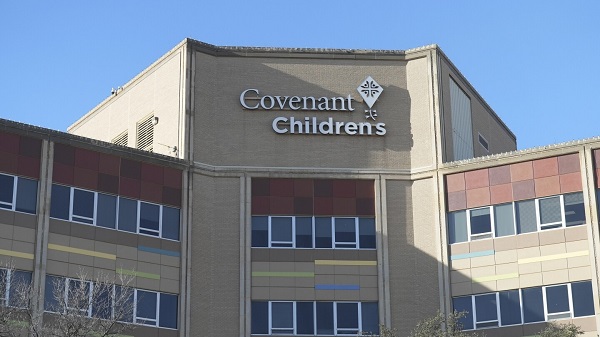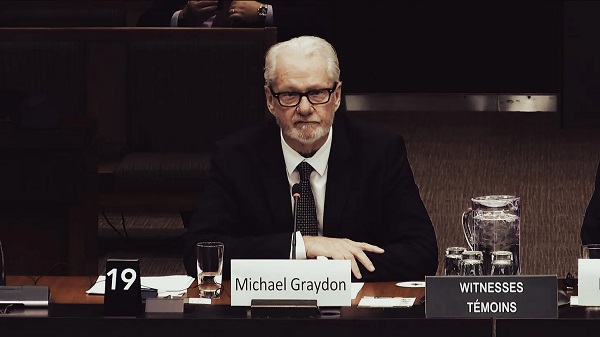Health
Expert Medical Record Reviews Of The Two Girls In Texas Who Purportedly Died of Measles

I have long reviewed medical records of patients harmed by poor medical care. Here, I present clear evidence of what actually caused the 2 girls deaths in Texas. It wasn’t measles.
Before I start, I want all to know that the parents of both children are from the same community and know each other. They and the community are obviously in grief over these unnecessary and easily preventable deaths, which you will learn more about why below. I will state at the outset that, in my professional opinion, neither child died of measles. Not even close.
CASE #1 – Kaley Fehr, Age 6
I will only briefly discuss Kaley’s case because it was already covered extensively in an interview I did with CHD TV a little over two weeks ago. Plus, the record and findings are straightforward.
Kaley was a six-year-old previously healthy girl who contracted measles along with her four siblings (all of whom weathered the illness just fine under the care of Dr. Ben Edwards). As her rash was clearing, she began to develop signs and symptoms of “secondary bacterial pneumonia,” a not uncommon complication of almost any viral infection. To wit, one of my three daughters fell ill with the same after she contracted influenza at age 14; however, in her case, she recovered from it two days after receiving an appropriate antibiotic.
In Kaley’s case, her worsening respiratory status led her parents to bring her to Providence Covenant Children’s Hospital in Lubbock, Texas, on 2/22/25 at 12:08 PM.
The hospital correctly diagnosed her with secondary bacterial pneumonia and then treated her with two antibiotics, ceftriaxone and vancomycin. This was a blatant deviation from the standard of care in treating hospitalized patients with “community-acquired pneumonia (CAP),” the guidelines for which have long recommended a different combination, e.g., ceftriaxone and azithromycin (or a quinolone).
Only azithromycin and quinolones cover mycoplasma pneumonia, a prevalent cause of community-acquired pneumonia (this is why the guidelines recommend them). Neither ceftriaxone nor vancomycin will treat mycoplasma because they work by disrupting the cell walls of bacteria. Mycoplasma does not have a cell wall.
Vancomycin, the antibiotic they chose instead of azithromycin, is used to treat “hospital-acquired pneumonia” as it is one of the only antibiotics that covers MRSA (methicillin-resistant staph aureus). This common organism inhabits hospitals and medical facilities. Kaley was from a rural Mennonite community and had not been in any hospital.
Despite her persistent and increasing deterioration in respiratory status, which eventually led to requiring intubation and mechanical ventilation, this deviation from the standard of care went unnoticed and uncorrected until just over a day before she died, when the test for mycoplasma returned as “positive.”
Azithromycin was then immediately ordered. However, from the chart, it appears it took ten hours before she received her first dose (documentation of the exact time may be missing). She was dead less than 24 hours later, 4 days after being admitted. The time of death was 06:43 on 2/26/25. My opinion as to the cause of death is that it was from an overwhelming lung injury called Acute Respiratory Distress Syndrome (ARDS) caused by mycoplasma pneumonia. The sole reason why she died from mycoplasma was because the initial antibiotic regimen violated the standard of care in the treatment of hospitalized community-acquired pneumonia because they neglected to treat her upon admission with azithromycin (i.e., a “Z-Pak deficiency”).
Note that azithromycin has excellent penetration into lung tissues and is highly effective at treating mycoplasma. Again, had they started azithromycin on Day 1, as has been recommended for decades, she would still be alive today.
The above findings were articulated in my interview with CHD TV on 3/19/25 but were subsequently ignored and/or distorted by the mainstream media. A reporter from USA Today reached out to Rebuild Medicine (my new non-profit) with questions. This is the exchange between my Executive Director and the reporter:
The above text also included links to several CAP guidelines, yet, in the USA Today article that was subsequently written about the case, the reporter 1) took a swipe at my credibility by describing me as a misinformationist, 2) did not even mention the treatment guidelines for community-acquired pneumonia that we had sent him, and 3) included parts of this below statement that the hospital released in response to my video interview. The mendacity of the below statement is astonishing:
“A recent video circulating online contains misleading and inaccurate claims regarding care provided at Covenant Children’s. Patient confidentiality laws preclude us from providing information directly related to this case. What we can say is that our physicians and care teams follow evidence-based protocols and make clinical decisions based on a patient’s evolving condition, diagnostic findings, and the best available medical knowledge. Measles is a highly contagious, potentially life-threatening disease that often creates serious, well-known complications like pneumonia, encephalitis and more.”
CASE #2 – Daisy Hillebrand, Age 8
I received Daisy’s medical records this past Monday via email at 5:55 p.m. Intrigued, I immediately dove in. I began reviewing and taking notes in an Excel spreadsheet because the records were not chronological. The printouts of the electronic medical record totaled 291 pages and came in 6 separate PDF files. It represented the total record for two separate admissions to the ICU of University Medical Center and one to Providence Covenant Children’s Hospital, all again located in Lubbock, Texas.
I worked continuously from 6 p.m. until 1:45 a.m., then put in another 2.5 hours more in the morning. Up until approximately midnight, my working impression of the cause of Daisy’s death was that it indeed was from measles pneumonia. Only after I opened and began reviewing the last file did I find data directly contradicting that impression. I had that initial impression because that was the “working diagnosis” of the ICU team, as documented in their daily notes.
In this case, I will start with my determination of the cause of death in the last admission. Then, I will provide details of the multiple poorly managed hospitalizations (understatement) that she suffered over the 4 weeks leading up to her death.
Cause of death: ARDS secondary to hospital-acquired pneumonia caused by a highly antibiotic-resistant E.Coli “superbug.” Based on the progression and trajectories of her illness, I believe that she contracted the infection from her first ICU admission, which is what caused her to return to the ICU 2 days after that discharge.
One of the tragedies (there were multiple) of this case is that the ICU team in charge of her care when she was re-admitted never considered the possibility of hospital-acquired pneumonia (HAP) until day 6 of 8. For an adult ICU specialist admitting a patient with an infection who was just discharged from an ICU, empiric treatment for hospital-acquired organisms is so basic and routine; I was shocked they did not do this.
In a minor defense of the pediatric team caring for Daisy, there are no published national treatment guidelines with specific antibiotic recommendations for the empiric treatment of hospital-acquired pneumonia (I did find one from the University of North Carolina (UNC), however). The first adult guidelines for HAP were published by the American Thoracic Society in 2005. Here we are 20 years later, and, aside from UNC, the field of pediatrics has not gotten around to doing the same. I found a paper by the Cochrane Library that proposed the methodology for creating one, but although published in 2019, it has not been completed yet. The American Academy of Pediatrics should be ashamed.
The problem for the hospital is that the absence of a treatment guideline is not why she died because had they sent a sputum culture on admission, by Day 3, they would have not only identified the organism but would have learned the antibiotic it was sensitive to and could have started it immediately. Her death on Day 8 would have likely and easily been prevented. Although they did send a urine culture, a blood culture, a viral PCR respiratory panel, and a PCR for MRSA and Staphylococcus (all of which were negative), they did not send a sputum culture. For a pneumonia.
For the sake of brevity, each time I detail a deviation from the standard of care in the below review of all three hospital stays, rather than explaining why it violates the standard in depth (and because I trust it will be evident to even laypeople), I will use baseball terminology by writing “strike” to indicate that “they missed the ball.” The failure to send a sputum culture in a patient with pneumonia who recently spent days in an ICU is Strike 1.
The failure to send a sputum culture had another tragic consequence – it allowed the care team, based on the viral respiratory panel being negative (which does not include measles PCR, by the way), to instead 1) assume that measles was the underlying cause on Day 2 and then, 2) immediately stop antibiotics in a seriously ill and infected child. Strike 2.
In the 8 days of her second hospital admission, she only received 5 days of antibiotics, and that is because, despite a rising white cell count in her blood, they did not restart antibiotics until Day 4, when she spiked yet another fever (Strike 3).
Further, during the three days Daisy received no antibiotics, she was given high-dose steroids. Please know that steroids, when paired with appropriate antibacterials, improve outcomes in pneumonia, but giving them without worsens outcomes. They presumably did this because their working diagnosis was “measles pneumonitis,” not bacterial pneumonia. The doctor in charge kept writing things like: “severe pulmonary sequela of measles infection around 3 weeks ago” and “we are concerned that the true extent of her lung injury due to measles is unknowable and it may be an end-stage process given the span of illness and the fact she truly is an outlier.” I don’t know what that last part means except that the clinical reasoning is unclear, and a broader “differential diagnosis” was not generated. At all.
Know that I have long taught my ICU residents and fellows the two guideposts that governed my care plans for critically ill patients. The first is, “If what you are doing is working, keep doing what you are doing.” This means that if their clinical trajectory was one of slow or steady improvement, sending endless diagnostic tests or adding therapies just because they were still ill is most often unnecessary.
The other was, “If what you are doing is not working, change what you are doing.” In this situation, I would re-review all the clinical data and further explore any causes I might be missing, or I would add on treatments that, although not standard, might offer benefit. I would try anything that might turn someone around, as long as the risk/benefit profile was favorable (when someone is persistently deteriorating, risk/benefit ratios change rapidly such that almost any treatment that holds the possibility for benefit is worthwhile to prevent death). In my opinion, at least.
With that in mind, I will say that I was encouraged by the one instance I found of the team “thinking outside the box” and trying a somewhat experimental treatment. They decided to give her intravenous immunoglobulin (IVIG)! One trial from China in 2015 found that IVIG improved outcomes in children with severe pneumonia (not measles-specific), and another study found that IVIG batches tested in 2021 contained measles-neutralizing antibodies. Good for them for trying something “off protocol.” Problem: they did not give her the IVIG until Day 7, one day before death.
Also, it was not until one day after re-starting antibiotics (Day 6) that they sent a sputum culture (Strike 4 – standard practice is to send a culture at the same time you start antibiotics). This was also the first time the thought that she might have HAP appeared in the record. This thought led them to then change her antibiotic to one that is routinely used for possible HAP (ceftazidime). Problem: The adult guidelines would have dictated that they start Imipenem or Meropenem, but since they don’t have a pediatric guideline published yet, I will not give them a strike for this.
Two days later, on Day 8, she died of refractory hypoxemia – they could no longer get oxygen into her blood via her lungs despite numerous heroic mechanical ventilation maneuvers. This, to me, is a condition that is akin to drowning in pus.
A few hours after her death, the sputum culture they sent on Day 6 was reported in the record (this is what caused me to change my working diagnosis as to the cause of her pneumonia). My jaw dropped as I read it: It showed 4+ growth of “E.Coli,” a nasty bug generally found in our GI tract only. If you don’t know what 4+ means, see this chart below, which explains the “semi-quantitative growth scale” for bacterial cultures:
If you think this can’t get any worse, you would be wrong: next came the panel of susceptibilities to a slew of antibiotics. Read it and weep:
Ampicillin – Resistant, Ampicillin/Sulbactam – Resistant, Aztreonam – Resistant, Cefazolin – Resistant, Cefepime – Resistant, Cefoxitin – Resistant, Ceftriaxone – Resistant, Cefuroxime- Resistant, Ciprofloxacin – Resistant, Levofloxacin – Resistant, Piperacillin – Resistant, Tetracycline – Resistant, Tobramycin – Resistant, and finally and tragically, Ceftazidime- Resistant.
It was sensitive to only a handful of antibiotics, one of which was meropenem, which is what would have been recommended by the Adult HAP Guidelines. Daisy had numerous risk factors for HAP (previous antibiotics, previous ICU, immunosuppressed, really sick, mechanically ventilated). In conclusion, an appropriate differential diagnosis for her pneumonia did not occur until Day 5, and a sputum culture was sent too late for them to discover that the antibiotic they selected was resistant to the organism she died from.
I am going to temporarily interrupt this post to warn you that, in the below reviews of the two hospital admissions she underwent in the week before the above “final” one, the above pattern of error-prone care and missed opportunities to save her life will continue.
HOSPITAL ADMISSION AT UMC 2 DAYS BEFORE THE FINAL ICU STAY
In this hospitalization, which began on 3/21/25, 6 days before the above admission, Daisy presented with typical symptoms of pneumonia along with a chest x-ray showing a left lower lobe process, classic for bacterial pneumonia. Her admitting diagnosis was “viral illness with probable secondary bacterial pneumonia.” Just like in Kaley Fehr’s case at Covenant Hospital, at UMC, they also decided to treat Daisy with the same inexplicable and standard-violating combination of ceftriaxone and vancomycin. Strike 1. However, Daisy did not suffer the same fate as Kaley because whatever bug was making her ill at this point, it appeared that it was sensitive to this combination, plus her mycoplasma test was negative. Near miss though. Not all medical errors lead to harm, and malpractice cannot be established without harm.
Although the mother was not aware that Daisy had a subtle rash on her back on admission, the ER physician suspected it was measles and sent off a PCR test, which returned positive on the day of discharge. OK, so she had measles too.
She was pretty sick lung-wise at first because she required admission to the ICU for oxygen support. However, her oxygen requirements decreased pretty quickly, her appetite improved, her rash began to “heal and fade,” and she was discharged home on oral antibiotics on Day 4. They prescribed her oral cefdinir, which was a fine choice, in my opinion, because she had responded to ceftriaxone in the hospital (a similar antibiotic).
Problem: in the discharge note, the doctor documented that “the parents appeared concerned” with the discharge and then reported that he/she had “reassured them.” Privately, Daisy’s father told me that was the same day her measles test came back positive, and he thinks that is why they sent her out so quickly. He felt she “didn’t look too good” and was concerned. I would have to agree with him based on the fact that she quickly began to get worse upon arriving home such that 2 days later, on 3/26/25, she had to return to the ER to be readmitted with what turned out to be the fatal E.Coli pneumonia episode I detailed above. My thought: she was beginning to fall ill with E.Coli pneumonia as she was being discharged (resistant to the cefdinir she left with).
I hope you have noticed that I have not overused the phrase, “If you think that was bad, it only gets worse.” If you allow me, I will invoke that phrase again here. Read on:
ADMISSION TO COVENANT HOSPITAL TWO DAYS PRIOR TO THE ABOVE UMC ADMISSIONS
If the sequence of events is confusing because I am “going back in time,” let’s change it up and start from the beginning so I can provide you with the timeline from the beginning of her illnesses.
Daisy had a history of chronic tonsillitis and was being scheduled for a tonsillectomy. A month before her death, as per Dr. Richard Bartlett, Daisy was diagnosed with mononucleosis and developed persistent fevers, which continued throughout the month, including all her hospital admissions. Daisy’s father told me that at one point in the first few weeks, she was also diagnosed and treated for strep at another facility, which Dr. Bartlett thinks was Seminole Hospital District (I don’t have the records for that visit). Then, late in the third week of her illnesses, she was admitted to Covenant Children’s Hospital in Lubbock, stayed one night, and was discharged. 2 days later, she was admitted to UMC for the first of her two hospital admissions there. We good with the timeline?
Now, we have to talk about what happened during her one-night stay at Covenant because had she been appropriately treated there, she would never have ended up at UMC, and all of the above would have been avoided.
Briefly, on 3/18/25, she was at a community health clinic where they found her to require oxygen, so she was sent to the ER. She complained of difficulty breathing, abdominal pain, nausea, and inability to eat and was found with thrush on exam. She had a recent Tmax of 103.7. A CT scan of the abdomen and chest was done, which found splenomegaly and a left lower lobe pneumonia surrounded by a small amount of fluid (e.g., a pleural effusion).
She was given IV ceftriaxone (no azithromycin – Strike), corticosteroids, a breathing treatment (albuterol), and a painkiller (Toradol). This was in the ER, and I do not have the records from the ER, just the hospital stay. She was then admitted to Covenant Children’s Hospital with the diagnosis of pneumonia with a “plan to transition to oral antibiotics in the a.m.” Strike 1 for the absence of azithromycin in her regimen. Again. 3rd hospital this has happened at in my reviews of these cases (someone please call the Department of Health in Texas). No sputum culture was ordered, although a blood culture was. Strike 2.
She was given oral amoxicillin and IV ceftriaxone (unnecessarily redundant coverage but not a strike), Motrin, and Tylenol (ugh, but not a strike). By the next day, her oxygen levels had improved, and she was eating OK, so they discharged her. Problem: the only medication she was discharged with, per the record, was the anti-fungal drug nystatin for the thrush. No antibiotics for her pneumonia. Strike 3, and I really mean Strike 3.
What? The only possible defense is that someone forgot what the CT showed (it appears the ED is separate from the hospital) and instead went by the chest X-ray (CXR) they did in the hospital. Why you would do a CXR on the same day she had a CT is beyond me (CTs are much more sophisticated and detailed).
I suspect the CXR caused the problem because it only revealed bronchial wall thickening. It missed the lower lobe process seen on CT, which is not uncommon as CXRs are much less sensitive to diagnosing pneumonia than CTs. The radiologist stated in his report that “bronchial wall thickening can be seen in asthma or viral illnesses.”
Below is the email with my preliminary findings that I sent to Brian Hooker, Chief Scientific Officer at Children’s Health Defense
I did a quick review, not detailed, but this is what I came up with, and I am again absolutely gobsmacked:
1) I can find no lab work in the chart; it appears from her discharge they did not do any
2) The admission note mentions a CT of the abdomen and chest. The CT abdomen revealed splenomegaly, and the CT Chest revealed a lower lobe opacity and a small pleural effusion. The reports are not included; I think they were done in another facility. The CT is diagnostic of bacterial pneumonia ( focal process with an effusion—i.e., not viral).
3) She was given antibiotics while in hospital but not upon discharge
OVERALL IMPRESSION: Left lower lobe bacterial pneumonia and thrush indicating an immunosuppressed status. They gave her one day of antibiotics for this bacterial pneumonia and then discharged her without an oral antibiotic regimen. She was discharged on 3/19. Two days later (3/21) was her first hospitalization to UMC… for a left lower lobe pneumonia, which landed her in the ICU. To me, this is a clear case of a “missed diagnosis.” Had she been given appropriate oral antibiotics upon discharge, the slow-moving train wreck at UMC would likely have been avoided. There are no words for this. I advise any parent or guardian of a young child to move from that area of Texas immediately in the event they ever need competent medical care. This is almost certainly a separate instance of medical malpractice for which this hospital and its pediatricians could be held liable.
Can you guys find out where the CAT scans were done and get records from that visit? It sounds like it was an outside ER or free-standing ER.
My short, narrative summary of what happened to poor Daisy:
Daisy became ill with mononucleosis a month before death, soon followed by a strep infection and then thrush. Fevers persisted throughout, and then three weeks after the mono diagnosis, she was admitted to Covenant Childrens, diagnosed with left lower lobe pneumonia, and treated successfully. However, she was sent home without oral antibiotics. Unsurprisingly, 2 days later, she was admitted to UMC’s ICU with measles and a worsening left lower lobe pneumonia, which was again, despite errors in antibiotic selection, successfully treated, and she was discharged despite concerns by her parents. The measles rash was clearing at this point. Then, 2 days after that, she was re-admitted to UMC’s ICU with a worsening CXR (now involving her right lung) and severely worsened oxygenation. Instead of suspecting a severe hospital-acquired bacterial infection and sending a sputum culture, the presumptive diagnosis was that her lungs were failing from measles pneumonia, and her antibiotics were stopped. She was instead given corticosteroids for “measles pneumonitis.” She continued to deteriorate despite their re-starting antibiotics on Day 4 and giving IVIG on Day 7. She died on Day 8 of what a few hours later was discovered to be a large amount of E.Coli in her sputum that was highly resistant to the antibiotics she was on.
I largely (and atypically for me as a writer) left out the many emotions I felt while writing this review. I will write a separate post to explore my thoughts about these two cases and why I think hospital care is deteriorating throughout the country, and not just in pediatrics. Recent papers have documented significant decreases in Americans’ trust in their hospitals and doctors (and media) compared to before Covid.
Further, these cases are being widely and repeatedly portrayed as “measles deaths” by a pharma-controlled press in an attempt to regenerate enthusiasm for vaccines (IMO by instilling exaggerated fears of measles (over 90% of measles cases are benign, and most complications can be easily treated with competent medical care). If the media continues to do this fear-mongering by using cases of non-measles deaths, public trust will plummet even further (or maybe I should say public distrust will skyrocket further).
I want to thank Dr. Ben Edwards and Dr. Richard Bartlett, who are in Lubbock doing everything they can to keep kids out of the hospital by delivering appropriate and effective outpatient care.
If you appreciate the pro-bono time and effort I put into performing these extensive case reviews and
researching and writing my posts, please consider a paid subscription.
Health
CDC’s Autism Reversal: Inside the Collapse of a 25‑Year Public Health Narrative

 James Lyons-Weiler, PhD, for Popular Rationalism
James Lyons-Weiler, PhD, for Popular Rationalism
On November 19, 2025, quietly and without ceremony, the U.S. Centers for Disease Control and Prevention updated its website and rewrote one of the most politically charged sentences in modern American medicine. A sentence that had been treated as gospel—“Vaccines Do Not Cause Autism”—was suddenly recast as something far more fragile. In the CDC’s own words, the slogan “is not an evidence‑based statement” because available studies “have not ruled out the possibility that infant vaccines contribute to the development of autism.”
Yet the headline still sits atop the page. Not because the CDC stands behind it, but because a U.S. Senator demanded it stay. CDC states plainly that the headline remains only due to an agreement with the chair of the Senate HELP Committee. A mandated political slogan now presides over a scientific reversal.
The body of the page reads like a confession. It acknowledges that key infant vaccines—including HepB, DTaP, Hib, PCV13, IPV, rotavirus, and influenza—have never been studied for autism outcomes. It admits that earlier studies used to justify the categorical claim were incapable of ruling out causation. It concedes that mechanistic and associative findings were ignored by health authorities. And it promises, for the first time, an HHS‑led effort to conduct “gold‑standard science” to evaluate whether early‑life vaccination can contribute to autism.
This moment did not arise in a vacuum. It is the final surface rupture of a 25‑year fault line running beneath CDC’s public messaging—a story of suppressed signals, discarded testimony, unpublished findings, internal dissent, FOIA‑released emails, whistleblower documents, and a lawsuit that forced CDC to walk back its own claim once before
The Early Warnings CDC Never Told the Public
In July 1999, the American Academy of Pediatrics and the U.S. Public Health Service issued a joint public statement urging the reduction or elimination of thimerosal in childhood vaccines. The stated reason was “an abundance of caution.” But in internal memos from FDA scientists revealed something more urgent: infants receiving vaccines according to the CDC schedule were exposed to mercury levels far exceeding EPA safety limits.
Behind the scenes, the alarm was palpable; in public, the message was reassurance.
One year later, in June 2000, CDC convened a closed‑door meeting at the Simpsonwood Retreat Center near Atlanta. The meeting brought together CDC officials, vaccine company representatives, and outside consultants to review early analyses from the Vaccine Safety Datalink (VSD). The transcript—obtained via Safeminds by FOIA—shows CDC epidemiologist Thomas Verstraeten presenting a dose‑dependent association between thimerosal exposure and neurodevelopmental disorders, with findings concerning enough that multiple attendees warned of “what this will mean” if made public.
In the months that followed, internal CDC emails—eventually released through persistent FOIA litigation—show Verstraeten repeating the same refrain: “It just won’t go away.” The association persisted despite multiple rounds of analytical restructuring.
But as the signal persisted, the public narrative hardened: vaccines are safe, and no link to autism exists.
2001: The IOM Frames the Outcome Before Reviewing the Evidence
In January 2001, the Institute of Medicine’s Immunization Safety Review Committee met to determine how it would approach vaccines‑and‑autism questions. The committee made two decisions that shaped every subsequent conclusion.
First, the IOM reported they would not review experimental animal data or mechanistic toxicology because the committee did not have “a free weekend” to do so.
Second, as revealed in the same transcript, the chair, Harvard pediatrician Marie McCormick, stated that CDC “wants us to declare” vaccines safe and that the committee was “not ever going to come down that autism is a true side effect.”
Study director Kathleen Stratton added that the predetermined outcome—“inadequate to accept or reject”—was the result “Walt wants,” referring to Walter Orenstein, then head of CDC’s National Immunization Program.
These statements were later entered into the Congressional Record.
The outcome—before any evidence was evaluated—was set.
The Verstraeten Disappearance
In 2002, before CDC’s thimerosal paper was published in Pediatrics, lead author Thomas Verstraeten left CDC to work for GlaxoSmithKline (GSK), a company producing thimerosal‑containing vaccines. The conflict was not disclosed in the paper.
2004: How Testimony and Mechanisms Were Removed
The IOM’s 2004 report on vaccines and autism excluded parental accounts of regression, mechanistic submissions detailing neuroimmune pathways, autism evidence involving vaccines other than the measles, mumps and rubella (MMR) vaccine and the growing literature on thimerosal‑related neurotoxicity.
Although the committee acknowledged that vaccines might trigger autism in a small biologically susceptible subset, it declared such a possibility insufficient to justify further research. It was the line CDC and AAP repeated for years.
At the same moment, statistician C.P. Farrington issued a methodological warning about the self‑controlled case series (SCCS) method—central to CDC’s MMR studies—explaining that SCCS can mask population‑level effects. This concern fell on deaf ears.
2007–2008: The Poling Precedent
In the Hannah Poling case, the federal government formally conceded via NVICP summaries that vaccines triggered a mitochondrial encephalopathy that manifested as autism.
This was the government’s first—and still one of its only—acknowledgments that vaccine‑induced autism can occur in a susceptible individual.
2014: The Whistleblower
CDC senior scientist Dr. William Thompson released a statement admitting that statistically significant findings related to MMR timing, race, and autism were omitted from a 2004 CDC study. His statement is preserved in the webarchive.
In 2015, Congressman Bill Posey read Thompson’s documents into the Congressional Record. In that same year, the groundbreaking documentary VAXXED reviewed the manipulation and destruction of data by CDC employees to bury the strong association of on-time MMR vaccination
2017: HHS Admits It Never Performed Required Vaccine Safety Reviews
Under pressure from a sweeping FOIA request, HHS disclosed that it had not performed the periodic vaccine safety reviews required under the 1986 National Childhood Vaccine Injury.
2017–2023: Aluminum, Microglia, and the Rewriting of Neuroimmunology
A growing scientific literature revealed significant concerns that aluminum in vaccines may play a increasing role: aluminum brain retention, macrophagic myofasciitis, dose‑dependent aluminum toxicity and toxicokinetic and clearance concerns.
Simultaneously, in a landmark review, the HHS Inspector General confirmed extraordinary underreporting in the Vaccine Adverse Events Reporting System.
These findings undermined the assumption that injected aluminum rapidly clears the body.
2018–2024: Maternal Immune Activation (MIA), IL‑6, and Autism Biology
Research on maternal immune activation reshaped autism biology indicates a direct role IL‑6–driven microglial priming, microglial dysregulation and pruning deficits, and immune‑activation neurodevelopmental changes.
These pathways perfectly match parental reports of regression following immune triggers, including fever and vaccination.
The 2018 IPAK Systematic Review
A systematic analysis by the Institute for Pure and Applied Knowledge (IPAK) examined 48 studies used by CDC and AAP to support the “vaccines do not cause autism” claim. The full report found that the key studies sent to President Trump in his first term, the average study quality score was –6.61 (on a scale where +12 represents a robust design); only one study scored above zero; most did not measure autism prevalence; none compared vaccinated vs. never‑vaccinated children; nearly all were retrospective correlation studies, unable to test causation. many were underpowered, overadjusted, or structurally incapable of detecting subgroups; and that studies showing associations were absent from CDC’s curated lists.
The Lawsuit That Forced CDC’s First Retraction
In the late 2010s, the Informed Consent Action Network (ICAN), led by Del Bigtree, filed a Data Quality Act challenge demanding CDC produce evidence that all vaccines on the infant schedule do not cause autism. CDC could not produce such evidence. The slogan was removed.
Under court order, the slogan was reinstated—until CDC’s 2025 update disavowed it again although the header remains as a purely political concession.
CDC’s 2025 Admission: The Narrative Has Collapsed
CDC now acknowledges that many infant vaccines have never been studied for autism. The website correctly reports that observational studies used to date cannot rule out causation. It also reports that mechanistic pathways were not evaluated. Most importantly, it reports that evidence showing association was ignored or suppressed.
The header, “Vaccines Do Not Cause Autism”, sticks out like a sore thumb, a\ reminder that it exists only because a U.S. Senator demanded it stay.
This is more than scientific refinement; it is a reckoning.
What Gold‑Standard Science Would Actually Require
A real determination about vaccines and autism would require a mix of retrospective prospective cohorts with fully unvaccinated controls. Genetic susceptibility profiling would be tracked with vaccine exposure and machine learning prediction modeling used to study exactly which risk factors could have predicted who would have developed autism. The prediction models optimized retrospectively would be to test prospectively and autism rates compared in kids removed from the vaccine schedule via clinical risk prediction.
Parents as Witnesses
For decades, parents have described regression events following vaccination—loss of language, eye contact, sociability, and developmental progress. CDC now admits these observations have never been properly studied.
These accounts are no longer anomalies—they align with known pathways of neuroimmune disruption.
Conclusion
CDC’s 2025 update is not a scientific conclusion. It is a confession of malfeasance by an organization whose entire paradigm on vaccine risk has not risk management, but rather, risk perception manipulation.
The question was never settled in spite of sufficient evidence that the correct studies are warranted.
“Gold‑standard science” is coming—twenty‑five years late. CDC is not changing its language because new evidence emerged. It is changing its language because the evidence it once relied upon was never sufficient to justify the claim.
Popular Rationalism is a reader-supported publication.
To receive new posts and support my work, consider becoming a free or paid subscriber.
Health
BREAKING: CDC quietly rewrites its vaccine–autism guidance

In a stunning shift, the CDC now says its own “vaccines don’t cause autism” claim was not evidence-based.
For the first time in a generation, the US Centres for Disease Control and Prevention (CDC) has rewritten its official position on whether vaccines can cause autism.
This is a change that could reshape one of the most politically charged and emotionally fraught debates in modern medicine.
In a website update published on 19 November 2025, the agency now states that the long-standing claim “vaccines do not cause autism” is “not an evidence-based claim” because scientific studies “have not ruled out the possibility that infant vaccines cause autism.”
The page also acknowledges that “studies supporting a link have been ignored by health authorities.”
It’s difficult to overstate the significance of these statements. For nearly two decades, they would have been unthinkable for a federal public health agency.
The timing is equally striking.
The change arrives at a moment when the political and scientific landscape around vaccine safety is undergoing a marked shift inside the Trump–Kennedy administration.
For months, critics have accused Health Secretary Robert F. Kennedy Jr and several of the administration’s appointees of holding unconventional views on vaccine safety.
The CDC’s revised language now places the agency closer to Kennedy’s long-standing argument that federal agencies had ignored crucial evidence.
The CDC explains the shift by pointing to the Data Quality Act, which requires federal communications to accurately reflect the evidence.
Because studies have not excluded the possibility that infant vaccines could contribute to autism, the agency concedes that its long-standing categorical statement was not scientifically justified.
The update states plainly that scientific uncertainty remains, particularly for vaccines administered in the first year of life.
Scientific uncertainty finally acknowledged
The information on the website draws a sharp distinction between the infant vaccine schedule — which includes DTaP, HepB, Hib, IPV, PCV and others — and the measles–mumps–rubella (MMR) vaccine.
For the MMR, the CDC continues to cite observational evidence showing “no association … with autism spectrum disorders,” describing the conclusion as supported by “high strength of evidence.”
But the agency also acknowledges that these studies had “serious methodological limitations” and were all retrospective epidemiological analyses, the type that cannot establish cause and effect or identify subgroups who may be more vulnerable.
The acknowledgement of limitations is unusually candid for a federal agency discussing vaccines and autism.
For the infant vaccine schedule, the shift is even more dramatic.
The CDC cites a series of authoritative reviews — including the 1991 and 2012 Institute of Medicine’s assessments, and the Agency for Healthcare Research and Quality’s review in 2021 — all concluding that the evidence was “inadequate to accept or reject” a causal relationship between early-life vaccines and autism.
In other words, the fundamental scientific question remains unresolved.
Political dynamite
The political context makes this change even more consequential. Senator Bill Cassidy, who chairs the Senate Health Committee, has been one of the most vocal critics of Kennedy’s vaccine views.
Cassidy has repeatedly insisted that the science on autism and vaccination was settled years ago. Now the CDC states that the claim “vaccines do not cause autism” does not meet evidence standards.
Remarkably, the CDC states that the headline phrase remains on the page only “due to an agreement with the chair of the U.S. Senate Health, Education, Labor, and Pensions Committee.”
The implication — that the wording is a political compromise rather than a scientific one — will undoubtedly invite scrutiny on Capitol Hill.
Attorney Aaron Siri, who has spent years litigating against federal agencies for greater transparency around vaccine safety, said the update marks a long overdue shift in honesty from the CDC.
“It is an excellent step in the right direction for CDC to start telling the truth to the public about its past misdeeds and misrepresentations,” said Siri.
“Telling the truth and apologizing for its prior misrepresentations is the only way the CDC will ever rebuild trust with the public,” he added.
How the Wakefield saga shaped debate
For years, any attempt to revisit the vaccine–autism question was coloured by the fallout from the “Wakefield saga.”
The retracted 1998 Lancet paper became a shorthand for misinformation, and it allowed public health agencies to dismiss all subsequent concerns as if they were simply a continuation of that controversy.
The episode became a kind of cultural firewall.
Invoking Wakefield was an easy way to shut down inquiry, even when parents were describing patterns that had nothing to do with the MMR vaccine and everything to do with the expanding infant schedule.
The CDC’s admission that the evidence for early-life vaccines is “inadequate to accept or reject” a causal link — and that some studies “supporting a link have been ignored” — breaks the long-standing habit of waving away legitimate questions by pointing back to a decades-old scandal.
A broad recalibration
The CDC’s shift also aligns with a broader recalibration underway across federal health agencies in the US.
The Trump administration has ordered new NIH reviews of vaccine safety science, reinstated the Task Force on Safer Childhood Vaccines, and rejuvenated the CDC’s Advisory Committee on Immunization Practices (ACIP).
The pattern is unmistakable: agencies that once treated certain questions as “settled science” are now reopening them and its impact is likely to reverberate across the globe.
The CDC now admits the science has not ruled out potential links for vaccines given in infancy.
The website also notes that “about one in two surveyed parents of children with autism” believe vaccination played a role, often pointing to shots given in the first months of life or around the one-year mark.
Until now, those parents were often told their concerns were baseless. The agency’s new wording fundamentally alters that dynamic.
Changing the conversation
In the US at least, public health agencies will no longer be able to respond to parental concerns with blanket denials.
Moreover, researchers studying plausible mechanisms — such as aluminium adjuvants, neuroinflammation, mitochondrial vulnerabilities and immune activation — will find themselves in an environment that formally recognises these questions as scientifically legitimate.
Informed consent practices may need to be revisited as the existence of uncertainty is formally acknowledged.
And lawmakers who insisted that the science was settled will now face uncomfortable questions about why federal agencies relied on definitive messaging that did not meet evidence standards.
To be clear — the CDC’s update does NOT assert that vaccines cause autism. What it does say — with clarity the agency has avoided for years — is that the available evidence has not established that they do not, at least for the vaccines given in early infancy.
That distinction may seem subtle, but it represents a profound shift in how the conversation is framed and will undoubtedly impact the personal experiences of families raising autistic children.
For the first time that I can remember, the question of vaccines and autism is no longer treated as taboo. It has been recast — at the CDC’s own hand — as a research question that demands proper investigation.
The shift may prove to be one of the most consequential public health developments of the decade, and it suggests that something significant is moving behind the scenes in the federal agencies that once seemed immovable.
OLD CDC WEBSITE:
UPDATED CDC WEBSITE:
Your paid subscription is what sustains my work.
Please upgrade your subscription to ensure independent investigations continue.
-

 Daily Caller2 days ago
Daily Caller2 days agoDemocrats Explicitly Tell Spy Agencies, Military To Disobey Trump
-

 Alberta1 day ago
Alberta1 day agoAlberta on right path to better health care
-

 Crime1 day ago
Crime1 day ago‘Modern-Day Escobar’: U.S. Says Former Canadian Olympian Ran Cocaine Pipeline with Cartel Protection and a Corrupt Toronto Lawyer
-

 Business2 days ago
Business2 days agoClimate Climbdown: Sacrificing the Canadian Economy for Net-Zero Goals Others Are Abandoning
-

 Great Reset2 days ago
Great Reset2 days agoAre climate-obsessed elites losing their grip over global politics?
-

 Business15 hours ago
Business15 hours agoCanada is failing dismally at our climate goals. We’re also ruining our economy.
-

 Daily Caller2 days ago
Daily Caller2 days agoALAN DERSHOWITZ: Can Trump Legally Send Troops Into Our Cities? The Answer Is ‘Wishy-Washy’
-

 Business2 days ago
Business2 days agoNearly One-Quarter of Consumer-Goods Firms Preparing to Exit Canada, Industry CEO Warns Parliament





















